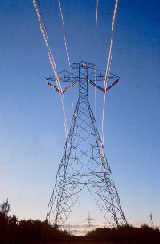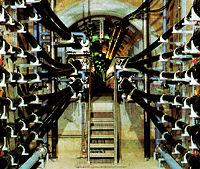Electric Power Generation, Transmission, and Distribution eTool
Illustrated Glossary » Transmission Lines
Transmission lines carry electric energy from one point to another in an electric power system. They can carry alternating current or direct current or a system can be a combination of both. Also, electric current can be carried by either overhead or underground lines. The main characteristics that distinguish transmission lines from distribution lines are that they are operated at relatively high voltages, they transmit large quantities of power and they transmit the power over large distances.
The types of transmission lines are:
Overhead AC transmission lines share one characteristic; they carry 3-phase current. The voltages vary according to the particular grid system they belong to. Transmission voltages vary from 69 kv up to 765 kv. The following are examples of different overhead transmission line structures in use today. The DC voltage transmission tower has lines in pairs rather than in threes (for 3-phase current) as in AC voltage lines. One line is the positive current line and the other is the negative current line.







Additional information:
- The Lineman's and Cableman's Handbook, Shoemaker, T. M., Mack, J. E., Tenth Edition 2002, McGraw-Hill.
Subtransmission lines carry voltages reduced from the major transmission line system. Typically, 34.5 kv to 69 kv, this power is sent to regional distribution substations. Sometimes the subtransmission voltage is tapped along the way for use in industrial or large commercial operations. Some utilities categorize these as transmission lines.





Underground transmission lines are more common in populated areas. They may be buried with no protection, or placed in conduit, trenches, or tunnels.








Additional information:
- The Lineman's and Cableman's Handbook, Shoemaker, T. M., Mack, J. E., Tenth Edition 2002, McGraw-Hill.

